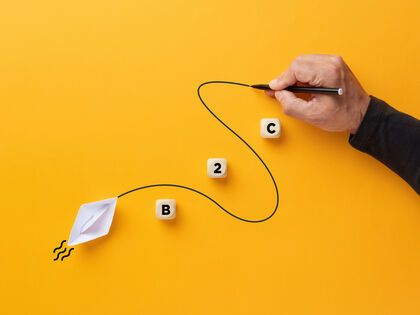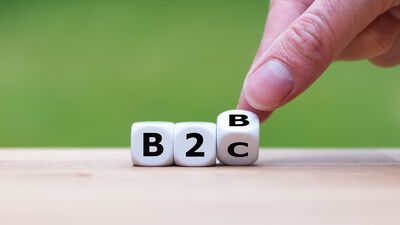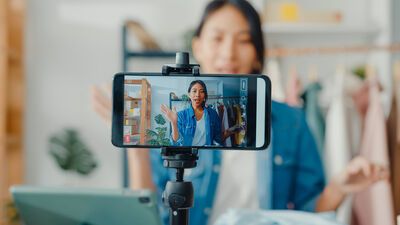
Consumer behavior is a fickle beast. Just when you think you’ve honed in on your customers’ habits, everything changes.
Take the pandemic.
Before COVID-19, did you buy groceries online, think about buying a bread maker, or worry about running out of toilet paper?
As a marketer, your efforts will fall short if you don’t stay on top of your industry. It doesn't matter whether your business is brick-and-mortar, eCommerce, or a combination. You need to know what your potential customers want to deliver a message of value.
HubSpot identifies five B2C trends marketers should lean into:
-
Short-form video
-
Influencer marketing
-
Audio content
-
Social responsibility
-
Inbound marketing
Let’s explore some B2C strategies that touch on these concepts. Then you can develop marketing tactics that raise brand awareness, generate leads, and increase sales.
What Is B2C Marketing?
Business-to-consumer (B2C) marketing is the practice of marketing products or services to consumers. This type of marketing applies to businesses that sell goods, such as food, clothing, and electronics. B2C businesses promote their products or services by making connections with consumers and urging them to buy.
To be successful, B2C companies must get to know their target market and create campaigns that appeal to their needs. The escalation of social media and other digital marketing channels makes it easier for businesses to reach and engage with their audience. As a result, B2C marketing efforts are more powerful than ever.
Do you have an inbound strategy?
What’s the Difference Between B2B and B2C Marketing?
Business-to-business (B2B) marketing is strategies used to market products and services to businesses. Some examples of B2B purchases include software, raw materials, and consulting. B2B marketing requires different tactics than B2C. B2B purchases are often high value and involve a complex process with several decision-makers. Businesses must nurture long-term relationships with B2B customers to close deals.

B2C marketing purchases are smaller in value, and the buyers are more impulsive. Consumers crave messaging that’s clear, compact, and candid. B2C buyers don’t want to dig for the benefits—they want you to tell them upfront. Consumers base decisions on emotions and need little time to make up their minds.
B2C Marketing Strategies
With B2C buyer traits and industry trends in mind, here are the elements you need to create your digital marketing plan. Your strategies should include:
-
Content marketing
-
Email marketing
-
Social media marketing
-
Influencer marketing
-
Messaging (SMS, push notifications, etc.)
-
Rewards (contests, freebies, etc.)
Let’s explain the value of each strategy and how to execute these methods to grab the attention of B2C buyers and convert them into new customers.
B2C Content Marketing
Inbound marketing—or attracting consumers to your business—is one of the top priorities for B2C marketers, says HubSpot. Content marketing is the cornerstone of this methodology. Businesses create, publish, and distribute content to attract, delight, and engage consumers. Examples include videos, blogs, podcasts, webinars, case studies, and white papers. While video remains popular, data suggests the use of audio content is rising.
B2C marketers most often use three types of content, according to the Content Marketing Institute:
-
Short articles/posts
-
Videos
-
Infographics/charts
But there’s a step you must take before you jump into writing blogs, recording videos, and designing infographics. You need to know what information your B2C buyers want.
Study your buyer personas to understand your prospective customers’ journeys. Then create engaging content that speaks to your consumers at each funnel level. As you build a library of resources, make sure each piece goes through search engine optimization (SEO), so your target audience can find it.
Your content marketing plan should reflect the four Ps of marketing (product, price, place, and promotion):
-
Treat your content as a product that must fulfill an informative, educational, or entertaining need
-
Consider the price of your content as email signups for gated material or followers on social media
-
Take your content to the places your customers visit by doing market research on platforms and websites
-
Promote your content on owned channels (website, email) and earned channels (social media, guest posts)
B2C Email Marketing
Inbound marketing also includes email marketing, which delivers content to the inboxes of the people who signed up for it. Email is one of the best B2C strategies because it’s a personal and popular medium. Experts expect the number of global e-mail users to reach 4.6 billion in 2025. Also, you own your email list, which means you control the messaging and functionality. You don’t have to deal with changing algorithms of social media channels and search engines.

To start your B2C email marketing strategy, get personal with your messaging. Study buyer data such as preferences, purchasing behavior, and browsing history. Make it easy for consumers to control what content they get—and when they get it. Mobile-friendly is a must. Use short subject lines, readable text size, and visible call-to-action (CTA) buttons. Make it easy on yourself, too. Create automated email campaigns that get triggered by actions or events.
When you invoke emotion and a sense of urgency in B2C buyers, they’ll take action. Insert emojis, memes, and images that grab attention and illustrate pain points. Include social proof and instill FOMO (fear of missing out) to spark interest. Use an upbeat and inspiring tone of voice to generate excitement. But don’t get too carried away—pop into the inbox and get to the point.
Need more info on social media strategy?
B2C Social Media Marketing
HubSpot says short-form video is the top trend B2C marketers are investing in this year. What better place to display that type of content than social media? B2C brands use a mix of organic and paid social media to reach their target audiences. In 2021, they most often turned to Facebook, Instagram, and LinkedIn for organic and paid content distribution. To impact B2C buyers on social media, you must show up and offer value.
In your paid social media approach, tailor your campaign to target your audience in order to meet your goals. Decide whether you’re looking to increase web traffic, brand awareness, lead generation, or other metrics. Show high-quality images or videos to catch consumers’ eyes. Create copy that’s clear, concise, and persuasive. Use strong calls to action (CTAs) to get users to click through to the next step. Incorporate retargeting to get your brand in front of people who’ve visited your site.
Deploy your organic social media strategy to build trust and drive engagement. Find interesting stories or facts related to your industry and publish them across your social media platforms. Create infographics or other visually appealing content that’s easy to share. Ask questions or start discussions on hot topics to get people talking. Share user-generated content from satisfied customers or brand fans. Don’t forget hashtags to make it easier for people to find your content.
Use social media to build a community around your brand. A solid group of supporters can provide valuable feedback to improve your products or services. B2C customers are also more likely to become ambassadors and promote your brand if they feel connected to your business.
Influencer Marketing in B2C
Working with influencers to advocate for your product or service expands your reach and grows your community. HubSpot asked B2C marketers which tactics provided the best return on investment (ROI). They chose influencer marketing over short-form videos, permanent social content, and SEO. Influencer marketing is the third-highest priority for B2C marketers, according to the survey.
To optimize your B2C influencer marketing strategy, start with your goals. Consider your budget and what kind of ROI you’re hoping to achieve. Examine your audience to determine what types of content are the most effective. It’s much easier to find the right influencers once you figure out your target market’s preferences.

Make sure your influencer partners share your values and align with your B2C brand. Buyers expect businesses to be transparent and take a stand on social issues—another consumer marketing trend. Work together to develop content that resonates with your specific audience and comes across as authentic and unfiltered.
To reach a large audience, partner with influencers who have a significant following. If you prefer quality over quantity, work with micro-influencers with fewer than 100K followers. Remember, platforms and algorithms are constantly changing, so what works today might not work tomorrow. Stay on top of your data to ensure your influencer campaigns are as effective as possible.
Messaging in B2C
As the world becomes more digitized, so does the way B2C marketers communicate with customers. Paper bills and snail mail are the media of the past. Today, businesses rely on various messaging tools to stay in touch with their clients. Short message service (SMS), push notifications, and chatbots are a few popular options.
In your B2C messaging strategy, use SMS as a quick and easy way to connect with your customer base. Sending text messages directly to a person's phone is ideal for time-sensitive information. Plus, it’s what consumers want—91% say they would sign up to receive texts from businesses. Don’t go overboard with the number of messages you send, though. You don't want to bombard your customers, but you also don't want them to miss important announcements.
Deploy push notifications to send messages that don't require a response, such as shipping updates and flash sales. These alerts keep B2C consumers informed after viewing a product, reading a blog, or surfing your website. But they’re not too intrusive. Explain the benefits to get consumers to opt-in, then keep messages simple and brief.
Install chatbots on your website and app to provide customer support beyond your human team. With this software, your business can answer questions about your product or service 24/7. Use chatbots to engage prospects, turn them into leads, and help them make purchases. If the conversation becomes too complex, the software can refer the B2C buyer to an agent during normal business hours.
Interested in paid media?
Rewards in B2C
Everyone loves free stuff! Contests, freebies, and loyalty programs are great ways to engage your followers and get them talking about your brand. These rewards can help you stand out from your competition and secure a strong following. The key is reflecting on what’s important to your customers and remaining authentic to your brand.
To develop your B2C rewards strategy, run contests with coherent rules, and make it easy to sign up. This tactic will build your email list, inspire social media sharing, and raise awareness of your platforms. Offer valuable prizes that reflect your customers’ values. For example, don’t give away a year’s supply of milkshakes if your service is a weight loss program. Instead, offer a year’s supply of healthy meal kits as the grand prize.
Give a freebie to a B2C buyer that pairs well with their purchase. A bonus gift increases the value of your product or service—and the likelihood that your customer will buy again. Personalize the customer experience to create a memorable and authentic connection. For example, if your customer buys a backpacking pack, throw in a matching daypack they can use for short hikes away from the campsite.
Offer a customer loyalty program to give consumers a way to earn rewards and redeem prizes. This approach encourages return visits, increases customer spending, and boosts brand visibility. Track data and analyze metrics to determine the most popular rewards. Arrange prizes by tier and put the most coveted at the top. For example, offer one point for every dollar spent on a product. Then let consumers cash in points on a range of prizes from low to high value.
Let a B2C Marketing Agency Help
Feeling overwhelmed? You don’t have to do all the things at once.
Start with one B2C marketing strategy and add more as you get comfortable. If you stay up on trends—and are open to adapting your methods—your business will stay competitive.
If you can’t spare the time or resources to improve your B2C marketing strategy, consider hiring a B2C marketing agency. At O8, we specialize in helping clients just like you create and execute successful B2C marketing campaigns.
View our B2C marketing portfolio today and get in touch to see how we can work together to grow your business.

